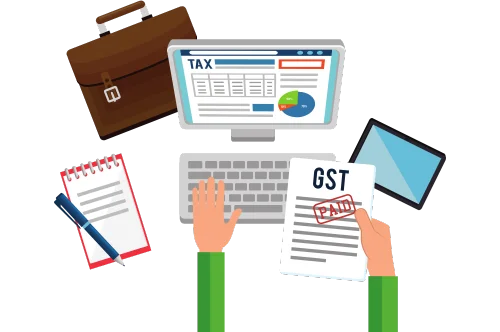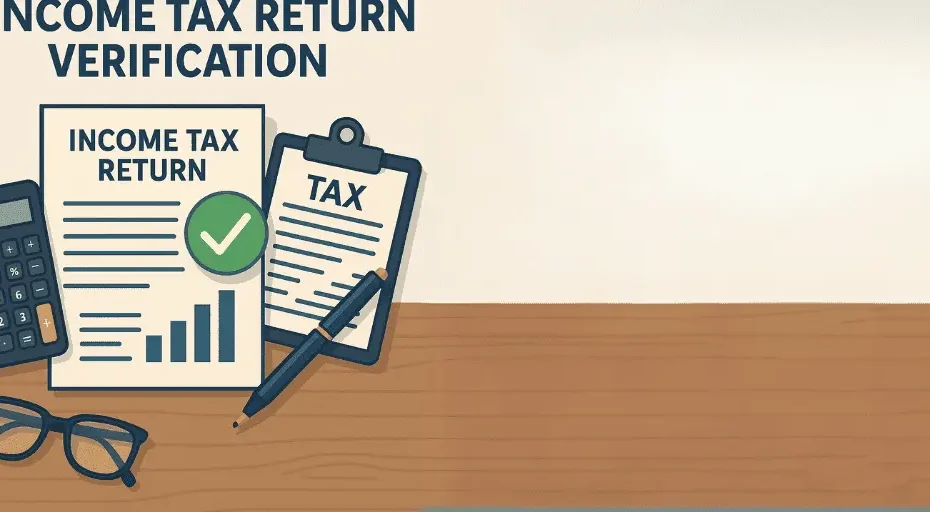Income Tax Return Verification: Methods & Deadlines
Filing your income tax return (ITR) is just one part of the process of fulfilling your tax obligations in India. Equally important, and often overlooked, is the step that follows: income tax return verification. This crucial phase ensures that your filed return is authenticated and accepted by the Income Tax Department. Without this verification, your return is considered invalid, which could lead to penalties and other complications.
In this blog, we’ll walk you through the various methods available for income tax return verification, the deadlines to keep in mind, and some useful tips to avoid common mistakes.
What Is Income Tax Return Verification?
Income tax return verification is the process by which the taxpayer confirms the authenticity of the return filed. After filing your ITR, either electronically or manually, you must verify it so that the Income Tax Department can begin processing your return. Until it’s verified, your ITR remains pending and is not considered valid.
There are two main ways to verify your ITR:
-
Electronically (e-verification)
-
Physically (by sending a signed ITR-V form to CPC, Bengaluru)
Let’s delve deeper into both these methods.
Methods for Income Tax Return Verification
1. E-Verification (Paperless Verification)
E-verification is the most convenient and widely recommended method of income tax return verification. It eliminates the need to send physical documents and is completed instantly in most cases. Here are the six ways to e-verify your ITR:
a. Aadhaar OTP
If your Aadhaar is linked to your PAN and mobile number, you can generate an OTP (One-Time Password) that will be sent to your registered mobile. Entering this OTP on the income tax portal completes your e-verification.
b. Net Banking
Log in to your net banking account and select the option to e-verify your ITR. You’ll be redirected to the e-filing portal where you can complete the verification.
c. Bank Account EVC
If your bank account is pre-validated and linked with PAN, you can generate an Electronic Verification Code (EVC) from the income tax portal to complete the verification.
d. Demat Account EVC
Similar to the bank account method, if your demat account is pre-validated, you can use it to generate an EVC.
e. ATM Verification
Some banks offer the option to generate an EVC through an ATM. This EVC can then be used on the e-filing portal.
f. Digital Signature Certificate (DSC)
For certain types of taxpayers, like companies and individuals under audit, a digital signature is mandatory for income tax return verification. You must register your DSC on the portal and use it for verification.
2. Physical Verification (ITR-V Form Submission)
If you’re unable to e-verify your ITR, you can opt for the physical method. This involves:
-
Downloading the ITR-V (Acknowledgement) form from the e-filing portal
-
Printing and signing it
-
Sending it via ordinary or speed post to:
Centralized Processing Center (CPC),
Income Tax Department,
Post Box No. 1,
Electronic City Post Office,
Bengaluru – 560100, Karnataka
This method takes longer, and it’s essential to ensure that the signed form reaches the CPC within the specified deadline. The Income Tax Department will send you an email or SMS upon successful verification.
Deadlines for Income Tax Return Verification
The deadline for income tax return verification is typically 30 days from the date of filing the return. This means:
-
If you filed your ITR on July 10, 2025, you must verify it by August 9, 2025.
-
Failure to do so will result in your return being treated as invalid, as if it were never filed.
Previously, the deadline used to be 120 days, but the Income Tax Department shortened it to speed up processing and reduce delays.
If the deadline is missed, you can submit a condonation request through the income tax portal, explaining the reasons for the delay. However, acceptance of this request is at the discretion of the assessing officer.
Consequences of Not Verifying Your ITR
Neglecting income tax return verification can have serious consequences:
-
Return Treated as Invalid: The return will be considered not filed at all.
-
Penalties: Late filing fees under Section 234F may apply if you refile.
-
Loss of Carry Forward: You may lose the benefit of carrying forward losses.
-
Refund Delays: If you’re eligible for a tax refund, it will not be processed until verification is complete.
Hence, completing the verification on time is as important as filing your ITR.
Tips to Ensure Smooth Income Tax Return Verification
Here are a few best practices to follow for seamless income tax return verification:
-
Link Aadhaar and PAN: This makes Aadhaar OTP verification quick and simple.
-
Pre-validate Bank/Demat Accounts: This is required for generating EVCs.
-
Double-check Deadlines: Mark your calendar to avoid missing the 30-day window.
-
Keep a Copy of ITR-V: If sending physically, retain proof of dispatch.
-
Use Reliable Postage: Prefer speed post over ordinary post for timely delivery.
Conclusion
Income tax return verification is a critical step in the ITR filing process that must not be ignored. With multiple methods available—ranging from Aadhaar OTP to net banking and digital signatures—taxpayers have a variety of easy and secure options to complete this step online. For those unable to e-verify, the traditional method of sending the signed ITR-V form is still an option.
Whether you’re a salaried individual, a freelancer, or a business owner, make sure to verify your return within the stipulated 30 days to avoid complications and ensure timely processing of refunds.
By staying informed and taking prompt action, you can ensure full compliance with income tax regulations and avoid unnecessary stress. Don’t let your efforts of filing an ITR go to waste—complete your income tax return verification today
Our GST Services

All E-commerce Tax services
E-commerce tax services help online sellers navigate GST registration, compliance, return filing, TCS management, tax planning, and audits, ensuring efficient tax management and legal compliance.

GST Filing
GST filing is the process of submitting tax returns to the government, detailing sales, purchases, and taxes paid or collected, ensuring compliance with GST laws.

GST Registration
GST registration is the process where businesses obtain a GSTIN from the government, allowing them to collect taxes, claim input tax credits, and comply with GST laws.





